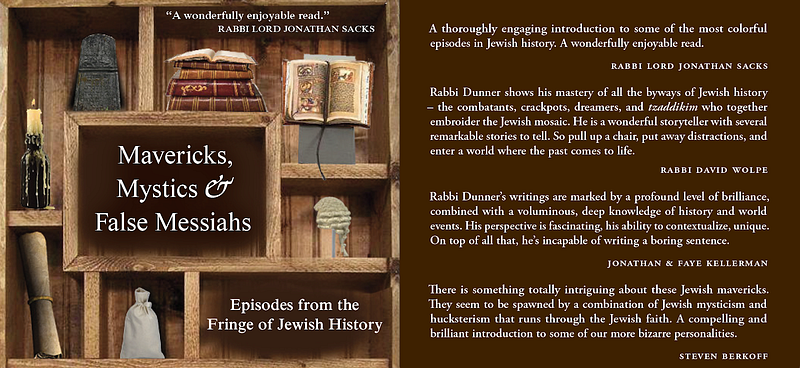Exploring the Fringe of Jewish History
Reviewing: “Mavericks Mystics and False Messiahs: Episodes from the Fringe of Jewish History” by Pinni Dunner. Toby Press, Jerusalem. 2018. English. 231 pages. ISBN-13: 978–1592645107.
Rabbi Pini Dunner’s Mavericks Mystics and False Messiahs: Episodes from the Fringe of Jewish History is an easy and light read. Dunner in his characteristic style reconstructs situations and (re)creates dialogue in order to bring the reader into the story.
Dunner chose to focus on specific individuals and episodes; some of which are well-known, and others less so.
The reader is first introduced to the 17th century notorious false Messiah Shabbetai Zvi and the peoples and situations that made him possible. The story is presented in a very linear manner which makes it easy to stay focused and process the information transmitted.
From there, he moves on to discuss the very colorful Polish-born, London-based Jewish mystic, Samuel Falk. I had come across Falk in my research on Sephardic Jews who settled in Eastern Europe (it is also indicative of how often -and successfully- Sephardim and Ashkenazim assimilated into each other’s culture). Dunner did not mention this factoid; Falk was apparently the son of a Sephardic Jew who apparently immigrated from somewhere in the Ottoman Empire. His original surname seemed to have been Laniado and he pronounced his Hebrew in a Sephardic dialect. (this is based on the research by British Chief Rabbi Dr. Herman Adler-from whence Dunner drew his information).
His focus on mystics takes a sharp turn towards the controversial when he devotes considerable space to the infamous fight between Rabbis Yaakov Emden and Yonatan Eybeschutz. I especially appreciated the quote cited from Emden in the introduction to this section whereas “a Rabbinic scholar cannot be ignorant of history and changing times”.
A notorious Jewish divorce case from 18th century Western Europe is put into context in his section on the “Get of Cleves” where power dynamics and Halakhic consensus experienced a standoff.
The very eccentric British convert to Judaism, Lord George Gordon is the focus of Dunner’s next article and it contains no shortage of drama and intrigue.
Rabbi Yehuda Rosenberg, whose more famous grandson was Mordecai Richler, often dubbed “the Canadian Phillip Roth”, is given a proper treatment by Dunner. His exposition on the intersection of fact and fiction is fascinating to say the least.
Finally the book concludes with the 20th century Hungarian adventurer/ rogue Ignac Trebitsch-Lincoln whose life story reads like a work of fiction proving the age old adage, Truth is indeed stranger than fiction.
Dunner takes pains to point out that he deliberately decided not to include footnotes and copious endnotes in this volume so as not to detract from the focus of the work. I applaud this move, as-in my estimation- this decreases the intimidation factor and makes it more user-friendly.
My only critique is the necessity for a bit more elucidation and detail. In the section on Shabbetai Sevi, for instance, I wish a word about the Donmeh was included. The Donmeh were Shabbetai Sevi’s hardcore followers who emulated his conversion into Islam, yet kept many Jewish traditions and only married among themselves up until recent times (they would also practice heterodox customs such as deliberately eating right before the end of the Ramadan fast).
I also wished that he would have devoted a bit more space to other individuals and movements. Perhaps I could suggest a sequel. Contenders for a future volume would include characters like: Zusia Zussman, the notorious forger of the Talmud Yerushalmi; Abraham Uri Kovner, forger and correspondent of Dostoyevsky; David Camden de Leon of South Carolina; Warder Cresson, America’s consul to Palestine who developed Jerusalem Syndrome and converted to Judaism; Two-Gun Cohen; Moses Wilhelm Shapira; Abraham Firkovich; Seraya Shapshal; Solomon Molkho; Kurban Said; Muhammed Weiss; Emin Pasha; Daniel Burros; Erik Jan Hanussen; Samuel Joseph Shereshevsky and others.
